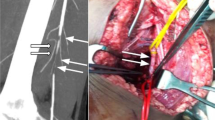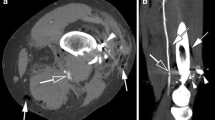Abstract
Purpose
CT angiography (CTA) has become a valuable tool in the assessment of suspected arterial injury in patients with penetrating lower extremity trauma. However, expensive imaging such as CTA should be judiciously utilized to ensure value-based care. We therefore assessed the yield of CTA in this setting at a level-1 trauma unit and correlated it with the clinical history provided.
Methods
A retrospective descriptive study from 1 July 2013 to 31 June 2018 at a 1386-bed, tertiary-level, public-sector teaching hospital in Cape Town, South Africa.. All patients undergoing CTA for suspected arterial injury following penetrating lower extremity trauma were included. The imaging yield of clinically significant arterial injury and the predictive value of specific clinical signs were determined.
Results
A total of 983 patients (median age 27 years, 91% male) were included; 90% (886/983) had gunshots, 9% (89/983) stabs, and 1% (8/983) other injuries. Despite an average 13% year-on-year increase in CTA performed, there was no change in the proportion demonstrating arterial injury. Thirty-four percent (23/68) of patients with strong (hard) signs of arterial injury (active pulsatile bleeding, rapidly expanding hematoma, absent pulse, palpable thrill, or audible bruit), 11% (49/459) with moderate (soft) signs (history of an arterial bleed, excessive non-pulsatile bleeding, large non-expanding hematoma, major neurological deficit, diminished but appreciable pulse, and arterial proximity), and 5% (24/456) with no indication for imaging had clinically significant arterial injuries. Significant positive correlations were rapidly expanding hematoma (p = 0.009), an absent pulse (p < 0.001), and a diminished pulse (p < 0.001). Significant negative correlations were proximity to a major artery (p = 0.005) and no clinical indication provided (p < 0.001).
Conclusion
There is poor correlation between clinical details provided and the presence of arterial injury at our institution. In this context, CTA serves a pivotal role in the definitive identification of arterial injury.
Similar content being viewed by others
References
WHO (2014) Injuries and violence: the facts. http://www.who.int/violence_injury_prevention/media/news/2015/Injury_violence_facts_2014/en/. Accessed 1 June 2020
Perkins ZB, De Ath HD, Aylwin C, Brohi K, Walsh M, Tai NRM (2012) Epidemiology and outcome of vascular trauma at a British major trauma centre. Eur J Vasc Endovasc Surg 44:203–209
Hofman K, Primack A, Keusch G, Hrynkow S (2005) Addressing the growing burden of trauma and injury in low- and middle-income countries. Am J Public Health 95:13–17
Hanche-Olsen TP, Alemu L, Viste A, Wisborg T, Hansen KS (2012) Trauma care in Africa: a status report from Botswana, guided by the World Health Organization’s “Guidelines for essential trauma care”. World J Surg 36:2371–2383
Jabar A, Matzopoulos R (2017) Violence and injury observatories: reducing the burden of injury in high-risk communities. South African Crime Quarterly 59:47–57
Norman R, Schneider M, Bradshaw D, Jewkes R, Abrahams N, Matzopoulos R et al (2010) Interpersonal violence: an important risk factor for disease and injury in South Africa. Popul Health Metr 8:1–12
Hafez HM, Woolgar J, Robbs JV (2001) Lower extremity arterial injury: results of 550 cases and review of risk factors associated with limb loss. J Vasc Surg 33:1212–1219
Dennis JWJ, Frykberg ER, Valdenz H, Huffman S, Menawat SS, Veldenz HC et al (1998) Validation of nonoperative management of occult vascular injuries and accuracy of physical examination alone in penetrating extremity trauma: 5-to 10-year follow-up. J Trauma - Inj Infect Crit Care 44:243–253
Rattan R, Jones KM, Namias N (2015) Management of lower extremity vascular injuries: state of the art. Curr Surg Reports 3:35
Feliciano DV (2010) Management of peripheral arterial injury. Curr Opin Crit Care 16:602–608
Feliciano DV, Moore FA, Moore EE, West MA, Davis JW, Cocanour CS, Kozar RA, McIntyre RC Jr (2011) Evaluation and management of peripheral vascular injury. Part 1. Western trauma association/critical decisions in trauma. J Trauma - Inj Infect Crit Care 70:1551–1556
Fox N, Rajani RR, Bokhari F, Chiu WC, Kerwin A, Seamon MJ, Skarupa D, Frykberg E (2012) Evaluation and management of penetrating lower extremity arterial trauma: an Eastern Association for the Surgery of Trauma practice management guideline. J Trauma Acute Care Surg 73:S315–S320
Busquéts AR, Acosta JA, Colón E, Alejandro KV, Rodríguez (2004) Helical computed tomographic angiography for the diagnosis of traumatic arterial injuries of the extremities. J Trauma 56:625–628
Colip CG, Gorantla V, LeBedis CA, Soto JA, Anderson SW (2016) Extremity CTA for penetrating trauma: 10-year experience using a 64-detector row CT scanner. Emergency Radiology 24:223–232
White PW, Gillespie DL, Feurstein I, Aidinian G, Phinney S, Cox MW, Adams E, Fox CJ (2010) Sixty-four slice multidetector computed tomographic angiography in the evaluation of vascular trauma. J Trauma - Inj Infect Crit Care 68:96–102
Iezzi R, Cotroneo AR, Pascali D, Merlino B, Storto ML (2007) Multi-slice CT (MSCT) angiography for assessment of traumatic lesions of lower limbs peripheral arteries. Emergency Radiology 14:389–394
Inaba K, Potzman J, Munera F, McKenney M, Munoz R, Rivas L, Dunham M, DuBose J (2006) Multi-slice CT angiography for arterial evaluation in the injured lower extremity. J Trauma - Inj Infect Crit Care 60:502–507
Mishra A, Bhaktarahalli JN, Ehtuish EF (2007) Imaging of peripheral arteries by 16-row multidetector computed tomography angiography: a feasible tool? Eur J Radiol 61:528–533
Peng PD, Spain DA, Tataria M, Hellinger JC, Rubin GD, Brundage SI (2008) CT angiography effectively evaluates extremity vascular trauma. Am Surg 74:103–107
Rieger M, Mallouhi A, Tauscher T, Lutz M, Jaschke WR (2006) Traumatic arterial injuries of the extremities: initial evaluation with MDCT angiography. Am J Roentgenol 186:656–664
Seamon MJ, Smoger D, Torres DM, Pathak AS, Gaughan JP, Santora TA, Cohen G, Goldberg AJ (2009) A prospective validation of a current practice: the detection of extremity vascular injury with CT angiography. J Trauma - Inj Infect Crit Care 67:238–243
Soto JA, Múnera F, Cardoso N, Guarín O, Medina S (1999) Diagnostic performance of helical CT angiography in trauma to large arteries of the extremities. J Comput Assist Tomogr 23:188–196
Wallin D, Yaghoubian A, Rosing D, Walot I, Chauvapun J, De Virgilio C (2011) Computed tomographic angiography as the primary diagnostic modality in penetrating lower extremity vascular injuries: a level I trauma experience. Annals of Vascular Surgery Inc. 25:620–623
Kabongo JM, Nel S, Pitcher RD (2015) Analysis of licensed South African diagnostic imaging equipment. Pan Afr Med J 22:1–9
Brownlee S, Chalkidou K, Doust J, Elshaug AG, Glasziou P, Heath I, Nagpal S, Saini V, Srivastava D, Chalmers K, Korenstein D (2017) Evidence for overuse of medical services around the world. Lancet 390:156–168
Hendee WR, Becker GJ, Borgstede JP, Bosma J, Casarella WJ, Erickson BA, Maynard CD, Thrall JH, Wallner PE (2010) Addressing overutilization in medical imaging. Radiology 257:240–245
Porter MP (2010) Perspective - what is value in health care? N Engl J Med 363:1–3
Dewey M (2018) The future of radiology: adding value to clinical care. Lancet 392:472–473
Fishman EK, Horton KM (2008) Multidetector CT and three-dimensional CT angiography for suspected vascular trauma of the extremities. Radiographics 28:653–666
Velez E, Surman AM, Nanavati SM, Kumar V, Lehrman E, Wilson MW, Conrad MB (2016) CT-detected traumatic small artery extremity injuries: surgery, embolize, or watch? A 10-year experience. Emerg Radiol 23:57–61
Feliciano DV, Moore EE, West MA, Moore FA, Davis JW, Cocanour CS, Scalea TM, McIntyre RC Jr (2013) Western Trauma Association critical decisions in trauma: Evaluation and management of peripheral vascular injury, part II. J Trauma Acute Care Surg 75:391–397
Wahlgren CM, Riddez L (2016) Penetrating vascular trauma of the upper and lower limbs. Curr Trauma Reports 2:11–20
Jordaan P, Roche S, Maqungo S (2016) Computerised tomographic angiography (CTA) in extremity trauma - a level one hospital experience. South African J Surg 54:11–16
Blackmore CC (2007) Defining quality in radiology. J Am Coll Radiol 4:217–223
Dowdall H, Gee M, Brison RJ, Pickett W (2011) Utilization of radiographs for the diagnosis of ankle fractures in Kingston, Ontario, Canada. Acad Emerg Med 18:555–558
Schwartz MR, Weaver FA, Bauer M, Siegel A, Yellin AE (1993) Refining the indications for arteriography in penetrating extremity trauma: a prospective analysis. J Vasc Surg 17:116–124
Reid JDS, Weigelt JA, Thai ER, Francis H (1988) Assessment of proximity of a wound to major vascular structures as an indication for arteriography. Arch Surg 123:942–946
Weaver FA, Yellin AE, Bauer M, Oberg J, Ghalambor N, Emmanuel RP, Applebaum RM, Pentecost MJ, Shorr RM (1990) Is arterial proximity a valid indication for arteriography in penetrating extremity trauma?: a prospective analysis. Arch Surg 125:1256–1260
Acknowledgements
The authors would like to acknowledge and thank Dr. J Odendaal for providing expert opinion on the management of vascular injuries, and Dr. Birhanu Bayele for his input regarding the study design and statistical analysis.
Data and materials availability
Uploaded as Electronic Supplementary Resource.
Author information
Authors and Affiliations
Contributions
Alwyn le Roux, Anne-Marie Du Plessis, and Richard Pitcher contributed to the study conception and design. Material preparation, data collection, and analysis were performed by Alwyn le Roux. The first draft of the manuscript was written by Alwyn le Roux with review and editing done by Richard Pitcher. All authors have read and approved the final manuscript.
Corresponding author
Ethics declarations
Ethics approval and consent to participate
The study was approved by the Health Research Ethics Committee of Stellenbosch University (S18/10/219) and the Western Cape Department of Health. Waiver of informed consent was obtained. The procedures used in this study adhere to the tenets of the Declaration of Helsinki. Waiver of informed consent was obtained from the Health Research Ethics Committee of Stellenbosch University due to the retrospective design of the study.
Consent for publication
Not applicable.
Conflict of interest
The authors declare that they have no conflict of interest.
Additional information
Publisher’s note
Springer Nature remains neutral with regard to jurisdictional claims in published maps and institutional affiliations.
Supplementary information
ESM 1
(XLSX 126 kb)
Rights and permissions
About this article
Cite this article
le Roux, A., Du Plessis, AM. & Pitcher, R. Yield of CT angiography in penetrating lower extremity trauma. Emerg Radiol 28, 743–749 (2021). https://doi.org/10.1007/s10140-021-01902-9
Received:
Accepted:
Published:
Issue Date:
DOI: https://doi.org/10.1007/s10140-021-01902-9




